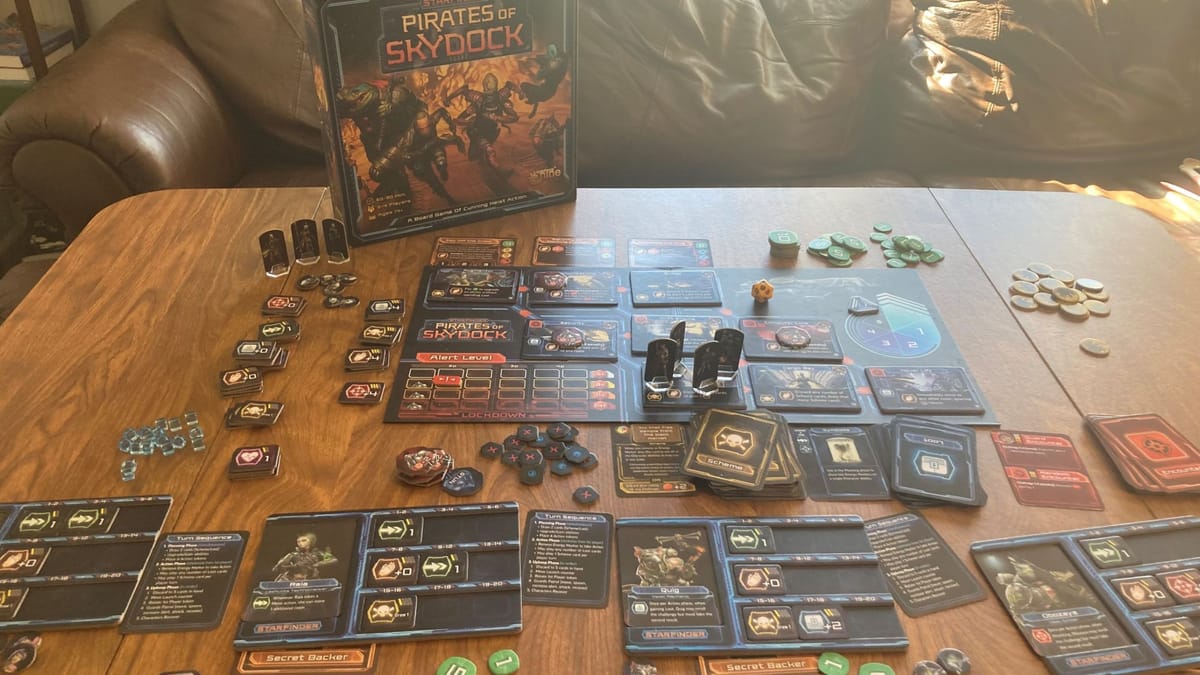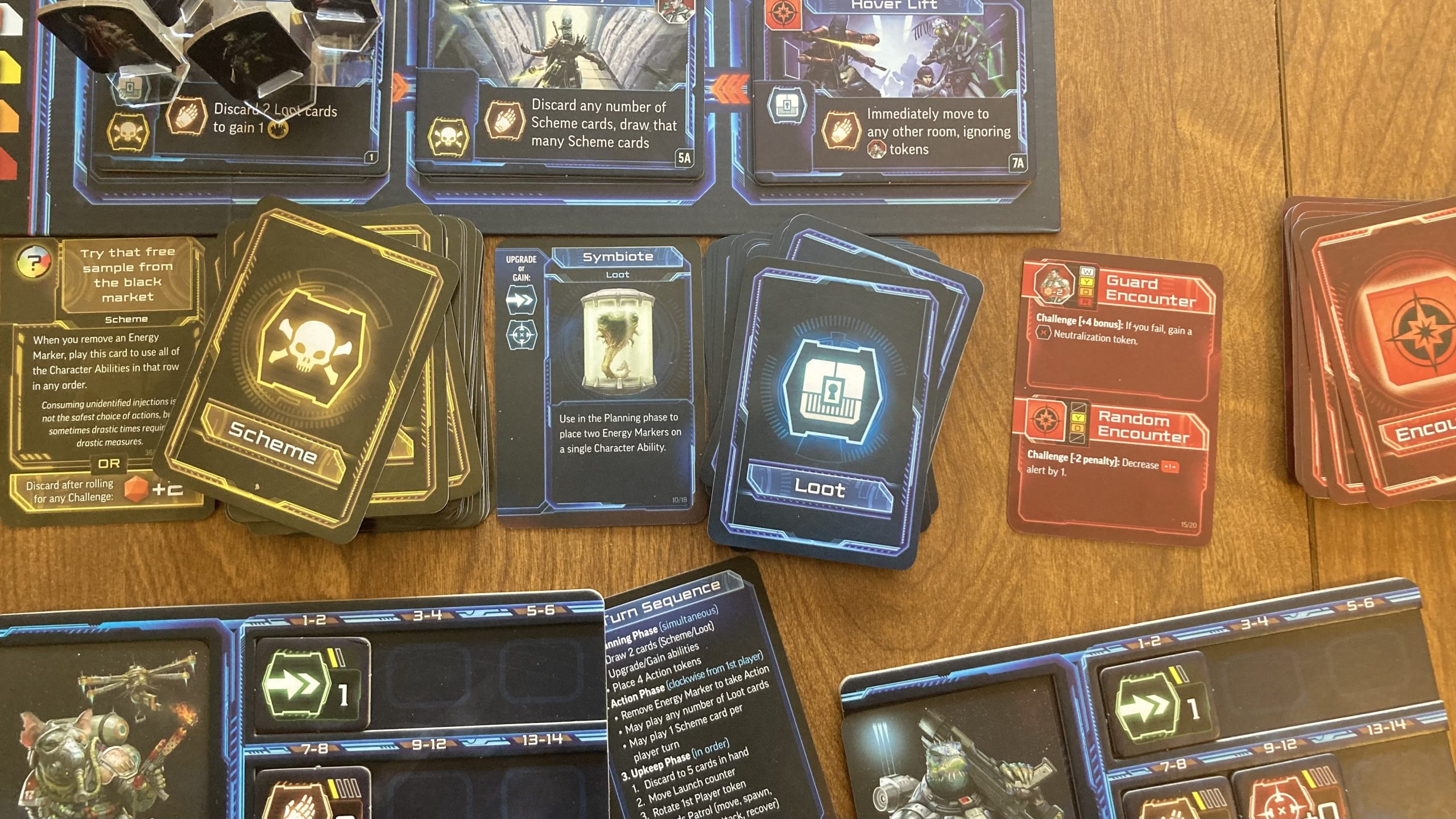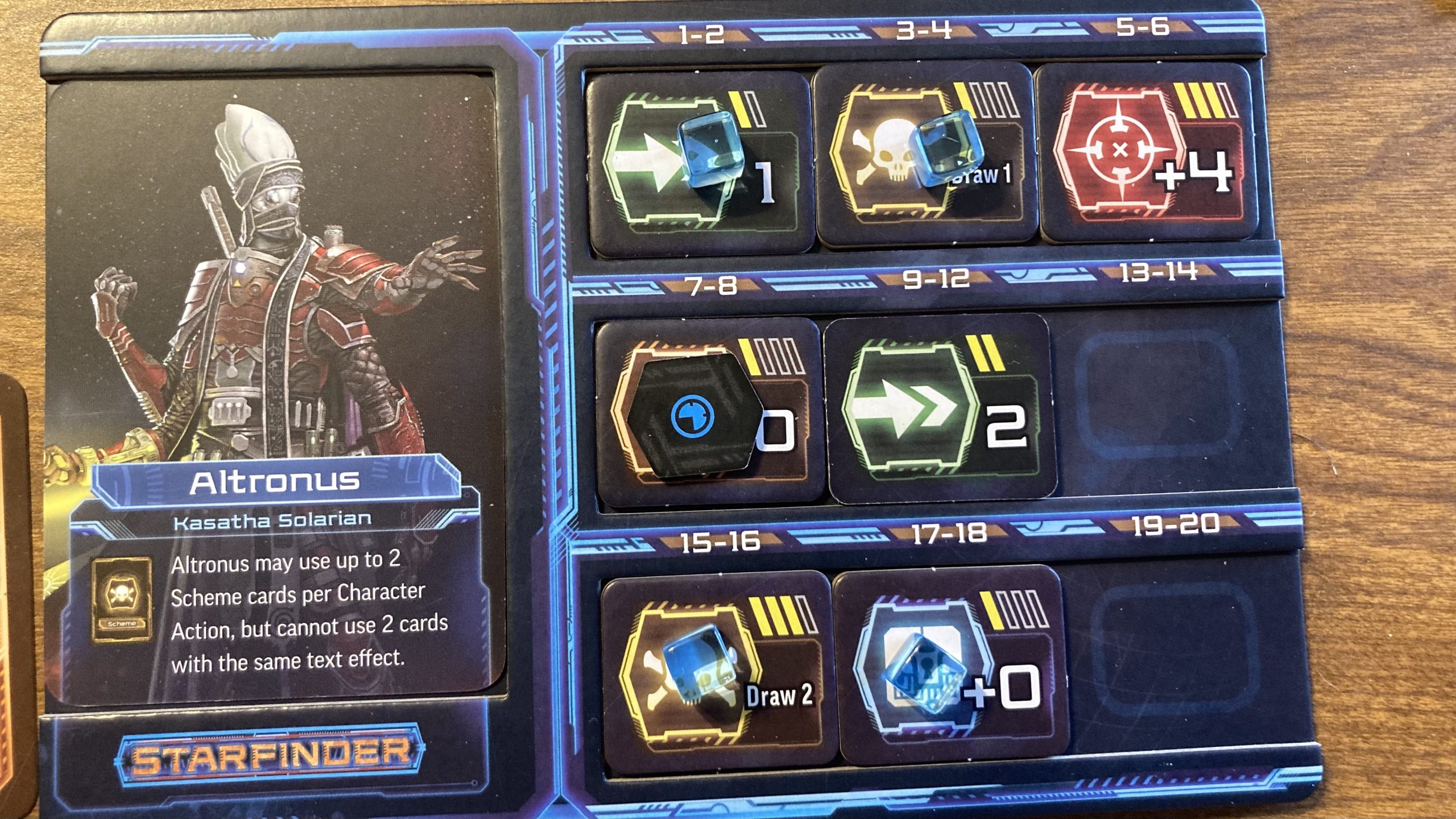
A great heist is iconic. Whether it’s in the movies, like the Ocean’s series or Gone in 60 Seconds, or in real life, a crew pulling off the biggest job captures the imagination. That’s what Gale Force Nine set out to accomplish with Starfinder: Pirates of Skydock. Players take on the roles of pirates looking to pull off the biggest heist imaginable: a top-of-the-line, state-of-the-art spaceship commissioned by an unknown benefactor.
The premise is engaging: you and your fellow players are trying to steal a spaceship while upgrading your abilities just like in Starfinder, a science fiction role-playing game by Paizo. In fact, the player board with the ability to upgrade your actions is one of the best parts of the game.
Does Pirates of Skydock follow through on the big heist premise? Not really. In actuality, the game is a race against time. The story goes that the ship is preparing to launch, so the players have only a certain amount of time to gain the support of the ship’s crew which is tracked by Glory and Support. Meanwhile, guards patrol the ship and encounters can raise the alert level of the ship. Too high of an alert and the ship goes into lockdown, preventing the ship from launching and anyone becoming the captain.
What happens is players move about the ship, leveling up their abilities and gaining cards in order to complete at least one objective. If the ship successfully launches, any players who have completed at least one objective will then total up their Glory and Support tokens to see who wins. The missions are drawn at random from a stack of cards, so you won’t play through the same list of objectives every time.
However, most of the objectives are fulfilled simply by gathering the right mixture of Scheme cards and rolling high enough on the included D20 when the character is in the right location. There are some objectives that can be completed in any location and even some that don’t require a roll of the dice, but the majority follow the same formula. There is some text on the objective cards in an attempt to immerse players, but it largely falls flat.

It’s unfortunately pretty easy to forget that this is supposed to be a high-stakes heist operation. The overly complex rules and the many boxes needing to be checked to meet the objectives left us referring to the rules so much that we were constantly pulled out of any semblance of immersion. Rather than planning a great heist, the objectives feel more like a to-do list.
Many of the aspects of the game were better in theory than in gameplay. One example is the semi-cooperative nature of the game. In theory, Pirates of Skydock is a semi-cooperative game. I say in theory because none of us worked together in any of the playthroughs. There is a mechanic for players to assist one another to complete objectives if someone is lacking some of the needed Scheme cards that sees both players drawing from a pool of facedown Support tokens. This never came up in any of our games because players would simply keep cycling through Scheme cards in search of what they needed. There’s even rules for using other Scheme cards to fill in for what you need.
Also, completing objectives results in you gaining Glory which is part of your end-game scoring. The amount of Glory on the objectives is always higher than the potential Support tokens. So you are effectively dropping your rewards while simultaneously boosting a competitor. While the mechanics are there to make Pirates of Skydock a semi-cooperative experience, it is entirely possible (and likely) that you will ignore this portion of the game.
Another example is the guards. Guards are an important part of any heist, providing tension, excitement, and fun when figuring out how to deal with them. The first few times we airlocked guards (and got the resulting Glory boost,) we enjoyed it, but there was very little tension or consequence to the choice. Players also have the option to stun the guard when they defeat them for a piece of loot but it seemed to almost always be an easy decision to airlock. Airlocking also removes the guard from the game, and there is no consequence to this unless the game drags long and you run out of the supply of guards. Then the alert level will rise every time a guard should be produced. So you may simply choose to stay away from guards in the latter stages simply to keep the alert level manageable, but that’s about the only tension that comes from the guards as you level up.
The box art looks good and evokes the theme of an epic heist. The character card artwork is also thematic and enjoyable, but a couple of the characters are too similar, making their small objective tokens hard to distinguish. The main board was fun with its interchangeability and prominent launch countdown. The locations themselves are made of thick cardboard, and have really nice artwork, but it is hard to appreciate it unless you are holding it up close (which is obviously not happening during gameplay). And the theme honestly left us wanting miniatures to represent the characters and guards rather than cardboard standees and tokens.

We did enjoy the way Skydock nodded to its RPG roots in Starfinder with the iconic D20, player boards, and level-up system. The player boards have a spot for your character card, which shows your starting stats on one side and your special ability on the other. Then there are slots where you can slide in the abilities, and throughout the game you can fill more abilities on your board and/or level your abilities up to a 4th level. Some of these abilities allow you to draw more cards, some give a bonus to die rolls, others extra movement/healing.
Overall, the theme is great, but the game overpromised and the gameplay itself failed to fully launch.
Starfinder: Pirates of Skydock
Mediocre
Starfinder: Pirates of Skydock is a roleplaying heist game that falls flat. It has some alluring flash, but feels like a heist where the treasure is more costume jewelry than real pirate treasure.
Pros
- The upgrade system genuinely feels like you are improving your character
- The D20 adds to the role-playing feel
- The multi-use cards are a great mechanic; the loot cards can be used to upgrade your character's abilities or for the text on the card, while the scheme cards are used to complete objectives, for their text abilities, or simply to add a +2 to your roll
Cons
- The game fails to incentivize or properly utilize the cooperative mechanic built in to the game
- It lacks immersion and consequently tension. It doesn't feel risky and lacks any real high-tension moments that heists should evoke.
- The thematic artwork on the room cards and the character tokens is not set up to shine due to the combination of details and the fact that the tokens and rooms are so small, you have to hold them to see everything.
